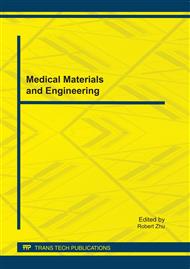[1]
Du H, van der A DL, Boshuizen HC, et al.: Dietary fiber and subsequent changes in body weight and waist circumference in European men and women. Am J Clin Nutr. 91(2010) 329-336.
DOI: 10.3945/ajcn.2009.28191
Google Scholar
[2]
Nothlings U, Schulze MB, Weikert C, et al.: Intake of vegetables, legumes, and fruit, and risk of all-cause, cardiovascular, and cancer mortality in a European diabetic population, J Nutr. 138 (2008) 775-781.
Google Scholar
[3]
McKeown NM, Yoshida M, Shea MK, et al.: Whole-grain intake and cereal fiber are associated with lower abdominal adiposity in older adults, J Nutr. 139 (2009) 1950-(1955).
DOI: 10.3945/jn.108.103762
Google Scholar
[4]
Qi L, van Dam RM, Liu S, Franz M, Mantzoros C, Hu FB. Whole-grain, bran, and cereal fiber intakes and markers of systemic inflammation in diabetes women, Diab Care. 29 (2006) 207-211.
DOI: 10.2337/diacare.29.02.06.dc05-1903
Google Scholar
[5]
Davis JN, Alexander KE, Ventura EE, Toledo-Corral CM, Goran MI: Inverse relation between dietary fiber intake and visceral adiposity in overweight Latino youth, Am J Clin Nutr. 90 (2009) 1160-1166.
DOI: 10.3945/ajcn.2009.28133
Google Scholar
[6]
Bazzano LA, Song Y, Bubes V, et al.: Dietary intake of whole and refined grain breakfast ceral and weight gain in men, Obes Res. 13 (2005)1952-(1960).
DOI: 10.1038/oby.2005.240
Google Scholar
[7]
Arpathsra Sangnark, Athapol Noomhorm. Effect of particle sizes on functional properties of dietary fibre prepared from sugarcane bagasse, Food Chemistry. 80 (2003) 221-229.
DOI: 10.1016/s0308-8146(02)00257-1
Google Scholar
[8]
Elena Lecumberri, Raquel Mateos, Marıa Izquierdo-Pulido, Pilar Ruperez, Luis Goya, Laura Bravo. Dietary fibre composition, antioxidant capacity and physico-chemical properties of a fibre-rich product from cocoa (Theobroma cacao L. ), Food Chemistry. 104 (2007).
DOI: 10.1016/j.foodchem.2006.12.054
Google Scholar
[9]
J.M. Fuentes-Alventosa, G. Rodríguez-Gutiérrez, S. Jaramillo-Carmona, J.A. Espejo-Calvo, R. Rodríguez-Arcos, J. Fernández-Bola, R. Guillén-Bejarano, A. Jiménez-Araujo. Effect of extraction method on chemical composition and functional characteristics of high dietary fibre powders obtained from asparagus by-products, Food Chemistry. 113 (2009).
DOI: 10.1016/j.foodchem.2008.07.075
Google Scholar
[10]
Kakuta M. Sone Y., Misaki A. Isolation and characterization of polysaccharides of kikurgae fruit body of Auricularia Auricula-judae, Agricultural Biology and Chemistry. 42 (1978) 417-422.
DOI: 10.1080/00021369.1978.10862990
Google Scholar
[11]
Bartnicki Garcia S. Cell wall chemistry, morphogenesis and taxonomy of fungi. Annual Review of Microbiology. 22(1968)87-108.
DOI: 10.1146/annurev.mi.22.100168.000511
Google Scholar
[12]
Ukai S. and Morisaki S. Polysaccharide in fungi Ⅶ. Acidic Heteroglycans from the fruit bodies of Auricularia Auricula-judae quell, Chemical & Pharmaceutical Bulletin. 30(1982) 635-641.
DOI: 10.1248/cpb.30.635
Google Scholar
[13]
Valentine A. Aletor. Compositional studies on edible tropical species of mushrooms, Food Chemistry. 54(1995) 265-268.
DOI: 10.1016/0308-8146(95)00044-j
Google Scholar
[14]
P. C. K. Cheung. The nutritional and health benefits of mushroom, British Nutrition Foundation Nutrition Bulletin. 35(2010)292–299.
Google Scholar
[15]
Femenia, A., Lefebvre, A. C., Thebaudin, J. -Y., Robertson, J. A., & Bourgeois, C. M. Physical and sensory properties of model foods supplemented with cauliflower fiber, Journal of Food Science. 62 (1997) 635-639.
DOI: 10.1111/j.1365-2621.1997.tb15426.x
Google Scholar


